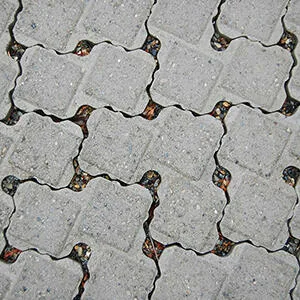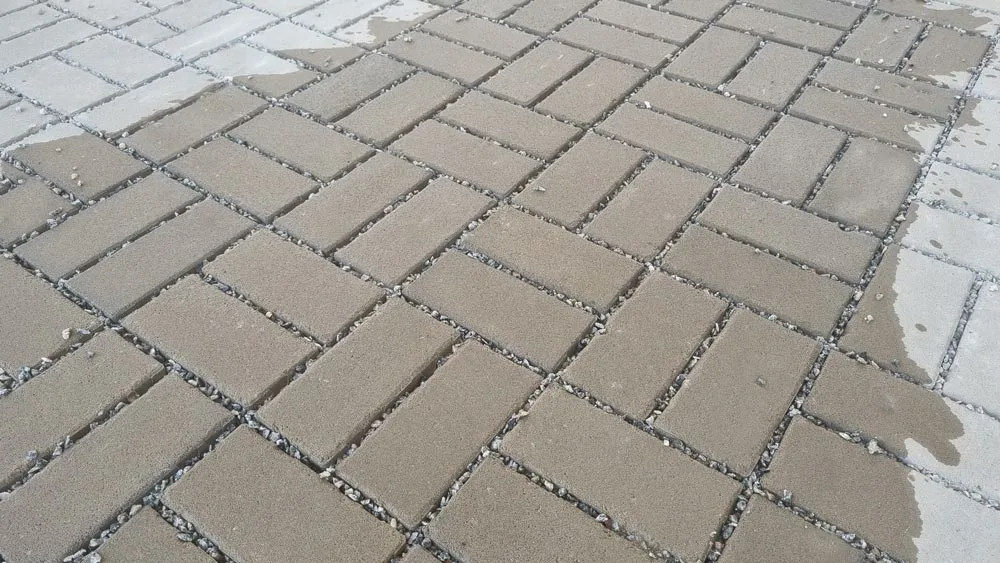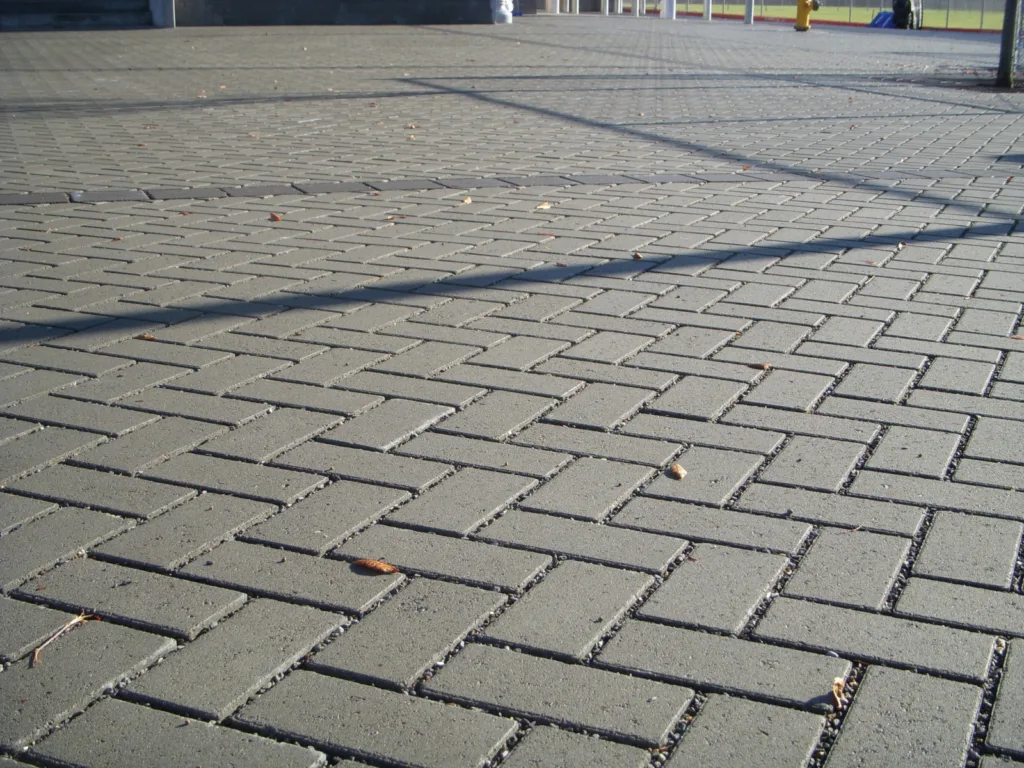Permeable pavement is a specialized paving system designed to allow water to pass through its surface, reducing runoff and promoting natural infiltration. It consists of porous materials such as previous concrete, porous asphalt, or permeable pavers with gaps filled with aggregate. The structure includes multiple layers that facilitate drainage while maintaining load-bearing capacity. By enabling water absorption, permeable pavement helps manage moisture levels, reduces surface water accumulation, and enhances durability.
Layers of Permeable Pavement
Permeable pavement consists of multiple layers designed to support loads while facilitating water infiltration and drainage. The typical layers include:
- Permeable Surface Layer – The top layer made of porous asphalt, pervious concrete, or permeable pavers that allows water to pass through.
- Bedding Layer (for paver systems) – A thin layer of crushed stone or aggregate that supports the pavers and helps distribute loads.
- Base Layer – A thicker layer of open-graded crushed stone that provides structural support and temporary water storage.
- Subbase Layer – A deeper layer of larger, clean-graded stone that enhances water storage and facilitates gradual infiltration into the subsoil.
- Geotextile (optional) – A fabric layer placed between the subbase and subgrade to prevent soil migration while allowing water to pass through.
- Subgrade (Natural Soil) – The existing ground, which should be well-prepared and compacted to ensure proper drainage and support.

Advantages of Permeable Pavement
- Reduces surface runoff by allowing water to infiltrate, decreasing pressure on drainage systems.
- Facilitates natural infiltration, replenishing underground water sources.
- Lowers the risk of urban flooding by preventing water accumulation.
- Minimizes heat retention compared to conventional pavements, keeping surfaces cooler.
- Reduces water flow velocity, preventing soil erosion in surrounding areas.
- Requires less frequent repairs due to its durability and self-draining properties.
- Reduces puddles and ice formation, enhancing skid resistance and road safety.
- Supports eco-friendly construction by incorporating recycled materials like Reclaimed Asphalt Pavement (RAP).
Methods for Laying Permeable Pavement
1. Cast-in-Place Method
In this method, a formwork is set up to define the pavement area, and the previous concrete or porous asphalt mix is poured into place. The mix is carefully leveled and compacted using rollers or screeds to maintain its porous structure. Unlike traditional paving, excessive compaction is avoided to prevent clogging of the interconnected voids that allow water infiltration. Proper curing is essential to achieve the required strength without sealing the pores.
2. Modular Installation Method
This method involves laying pre-manufactured permeable pavers over a prepared subbase. A thin bedding layer of fine crushed aggregate is first spread and leveled to support the pavers. The pavers are then placed in a designed pattern, with small gaps between them for water infiltration. These gaps are filled with permeable joint material, such as clean crushed stone, to facilitate drainage. After placement, the entire surface is compacted to ensure proper interlocking and stability.
3. Grid System Installation Method
The grid system method uses plastic or concrete grids that create a strong, permeable surface suitable for both vehicular and pedestrian traffic. Installation begins with a compacted sub base of crushed stone to provide structural stability. The grid units are then placed and interlocked, forming a framework that is filled with gravel, sand, or soil. When filled with soil, the grids support grass growth, blending seamlessly with green landscapes while maintaining load-bearing capacity.
4. Layered Aggregate Method
This method involves constructing a deep base of clean, crushed stone to provide both stability and water infiltration. The sub base consists of large, open-graded aggregate that allows water storage, while a finer base layer helps distribute loads. The top layer comprises loose, angular gravel that remains porous and prevents surface water accumulation. Unlike traditional paved surfaces, this method requires occasional raking and refilling to maintain permeability.
5. Detention-Based Permeable Pavement
Designed for areas requiring stormwater management, this method incorporates a layered subbase that temporarily stores rainwater before slowly releasing it into the ground. A deep base of open-graded aggregate serves as a water retention layer, often combined with perforated pipes to regulate outflow. The top surface can be pervious concrete, porous asphalt, or permeable pavers, ensuring efficient water infiltration while maintaining durability.

Equipment Used for Laying Permeable Pavement
1. Site Preparation Equipment
Proper site preparation is importantl for a stable foundation and ensuring efficient water infiltration.
Excavators & Backhoes
Excavators and backhoes are used to remove existing pavement, vegetation, or debris from the site and excavate the area to the required depth. These machines help shape the subgrade and ensure that the foundation is properly prepared to support the layers of permeable pavement. Hydraulic-powered attachments allow precise control, making excavation efficient and minimizing disturbance to surrounding areas.
Graders & Bulldozers
Graders are used to level the subgrade, creating an even surface that ensures proper drainage and water infiltration. Bulldozers help in moving and spreading soil or aggregate over large areas quickly, allowing for uniform grading. Maintaining the correct slope is essential to prevent water pooling and ensure efficient infiltration.
Compactors & Rollers
Compaction is necessary to provide stability while maintaining permeability. Vibratory plate compactors and drum rollers are commonly used to compact the subgrade and aggregate layers. Over-compaction is avoided in previous concrete or porous asphalt installations to prevent reducing the void spaces that allow water to pass through.
2. Base & Subbase Installation Equipment
The base and subbase layers play an important role in supporting the pavement structure while allowing water storage and infiltration.
Stone Spreaders
Stone spreaders are used to evenly distribute open-graded crushed stone across the subbase layer. This ensures a uniform load distribution and maintains the void spaces required for effective drainage. The controlled spreading of aggregates helps achieve consistent thickness across the pavement area.
Vibratory Plate Compactors
Vibratory plate compactors are used to compact the crushed stone base without compromising permeability. Unlike traditional compactors, these machines ensure stability while keeping the air voids open, allowing for efficient water infiltration. They are typically used in multiple passes to achieve the desired compaction level without sealing off the surface.
Geotextile Rollers
Geotextile fabric is often placed between the subbase and subgrade to prevent fine soil particles from migrating into the permeable stone layers, which could reduce drainage efficiency. Geotextile rollers help in unrolling and positioning the fabric smoothly, ensuring complete coverage with minimal overlaps and wrinkles.
3. Paving Equipment
Once the base layers are prepared, the pavement surface is installed using specialized equipment suited to the type of permeable pavement being laid.
Concrete Mixers & Trucks
For pervious concrete, concrete mixers are used to prepare the mixture with the correct water-to-cement ratio to maintain porosity. Concrete trucks transport the mix to the site while keeping it in constant motion to prevent setting. Proper mixing is essential to ensure the final pavement structure remains durable and permeable.
Asphalt Pavers
Porous asphalt requires specialized asphalt pavers for uniform application. These machines lay the asphalt mix while ensuring the required thickness and even distribution. The screed mechanism prevents excessive compaction, which could otherwise close the voids needed for permeability.
Screeds & Trowels
Screeds are used to level pervious concrete surfaces, ensuring a uniform finish while maintaining the necessary voids. Trowels help in finishing edges and joints, but over-smoothing is avoided to prevent sealing the porous surface. Mechanical screeds are often used for large areas, while manual trowels are used for smaller sections and detailing.
Paver Laying Machines
For permeable interlocking concrete pavers (PICP), automated paver laying machines are used to place multiple pavers in an efficient and aligned manner. These machines improve installation speed and ensure consistent joint spacing, which is important for maintaining water infiltration pathways.

Applications of Permeable Pavement
- Sidewalks & Pedestrian Paths
- Public Plazas & Courtyards
- Bicycle Lanes
- Commercial & Residential Parking Lots
- Driveways & Access Roads
- Overflow & Temporary Parking Areas
- Low-Traffic Roads
- Shoulders & Medians
- Emergency Vehicle Lanes
- Factory & Industrial Yards
- Parks & Gardens
- Playgrounds & Outdoor Seating Areas
- Retention & Detention Basins
- Riverbanks & Wetlands Protection
- Green Infrastructure Projects
- Airport Runoff etc.
Conclusion
Permeable pavement is a practical and sustainable solution for modern infrastructure, offering effective stormwater management while maintaining strength and durability. Its ability to reduce runoff, prevent flooding, and support groundwater recharge makes it an ideal choice for urban and environmental applications. As cities and industries focus on eco-friendly construction, permeable pavement continues to play an important role in resilient and water-efficient infrastructure.

